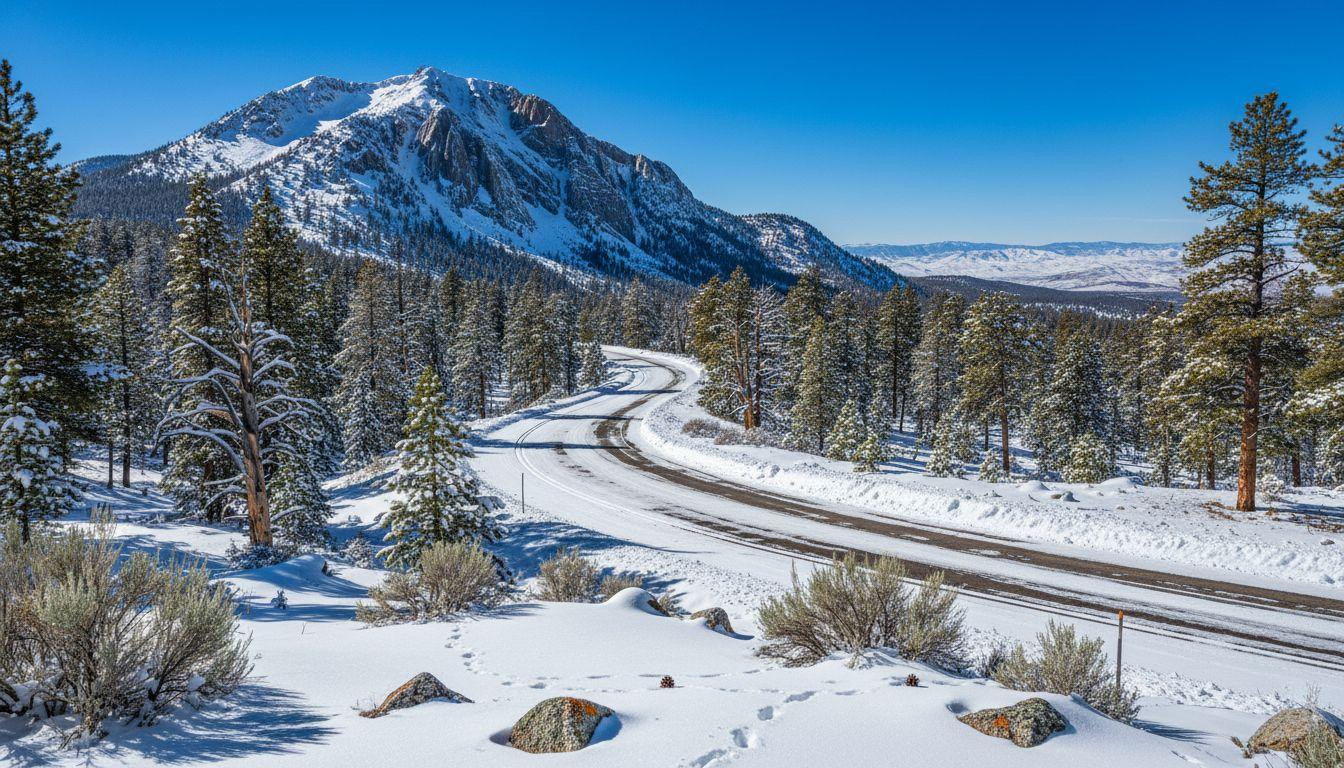Most travelers picture Nevada as endless desert punctuated by casino lights. They never imagine a 12-mile mountain road that transforms into America’s quietest cross-country ski trail when winter snow forces it closed. Wheeler Peak Scenic Drive in Great Basin National Park becomes something magical between November and April. Cars vanish, silence returns, and alpine wilderness opens to those willing to strap on skis.
The road climbs 3,200 feet from Baker’s desert floor to Wheeler Peak’s alpine zone. Most Americans have never heard of this place. Nevada’s second-highest peak rises to 13,063 feet, creating dramatic temperature shifts within a single drive. Baker sits at 5,300 feet where sagebrush dominates the landscape.
Where desert meets alpine wilderness
Baker, Nevada holds 70 residents and serves as the unlikely gateway to alpine adventure. The town sits 285 miles from Las Vegas and 230 miles from Salt Lake City. Visitors often arrive skeptical that Nevada contains snow-covered peaks. The Wheeler Peak Scenic Drive proves them wrong within minutes.
The road begins innocuously enough through Great Basin’s desert floor. Joshua trees and sagebrush line the first mile. Then elevation starts working its magic. Pine trees appear at 7,000 feet. Aspen groves emerge at 8,500 feet. By 10,000 feet, the landscape resembles Colorado more than Nevada.
Great Basin National Park sees only 130,000 visitors annually compared to Zion’s 5 million. Winter reduces that number to hundreds. The granite peaks and pristine snow create conditions that rival famous alpine destinations without the crowds.
When the road becomes a winter trail
Snow transforms the driving experience
Wheeler Peak Scenic Drive typically closes by November 1st after the first significant snowfall. The National Park Service gates the road, creating a natural cross-country ski corridor. Snow accumulates steadily through winter, reaching depths of 3-5 feet by January at higher elevations.
The closed road provides perfect skiing terrain for intermediate adventurers. The first 2 miles offer gentle grades through pine forests. Miles 3-6 challenge skiers with steeper climbs toward the treeline. Advanced skiers can push to mile 8 where Wheeler Peak’s granite cirque opens spectacular views.
Silent season rewards persist
Winter brings absolute quiet to Wheeler Peak. No engines, no crowds, no commercial development. Clark’s nutcrackers call from whitebark pines. Wind whispers through ancient bristlecone pine groves. Ski tracks often remain the only human sign for days.
Nevada’s dry climate creates powder snow that rivals Colorado’s famous conditions. January through March offers the most reliable snow coverage. Early season visitors in November may find patchy coverage, while April brings spring melt conditions.
The winter skiing experience
Cross-country skiing the scenic road
The road’s design accommodates winter recreation perfectly. Park Service maintenance crews clear initial sections for emergency access but leave the upper road naturally snow-covered. Skiers park at the gate and begin their journey into wilderness.
Elevation gain totals 3,200 feet over 12 miles, creating manageable grades for cross-country equipment. Most visitors ski 4-6 miles before turning back. Strong skiers can reach Wheeler Peak Campground area where views extend across Nevada’s Basin and Range country.
Alpine zone access without lifts
Wheeler Peak’s alpine environment exists nowhere else in Nevada. Ancient bristlecone pines cling to exposed ridges. Some trees exceed 3,000 years in age. Winter snow creates access opportunities to normally crowded summer hiking areas.
The peak’s cirque contains Nevada’s only glacier, though seasonal weather patterns continue shrinking its size. Rock glaciers and permanent snowfields provide dramatic backdrops for winter photography. Skiers often have these alpine views entirely to themselves.
November 2025 conditions and timing
Current snowpack measurements show 5 inches at 10,120 feet elevation as of late November 2025. This represents 19% of normal levels for this date. Early season visitors should expect variable conditions and potential bare ground on south-facing slopes.
Park officials recommend checking current conditions before travel. Road closure timing varies based on snowfall patterns. Some years see closure by mid-October, others remain open into early December. Low visitor numbers mean flexible planning yields the best experiences.
January through March typically provide the most reliable snow conditions. February averages the deepest snowpack with consistent below-freezing temperatures. March offers longer daylight hours while maintaining good snow coverage.
Your questions about Wheeler Peak winter skiing answered
Do I need backcountry skiing experience?
The road’s gentle grade suits intermediate cross-country skiers comfortable with elevation gain. Avalanche danger exists in steep terrain above the road but not on the road itself. Standard cross-country equipment works well. Visitors should carry emergency supplies including extra food, water, and warm layers.
Where do I stay near Great Basin?
Baker offers basic accommodations ranging from $70-100 per night in motels and cabins. Limited dining options focus on hearty Western fare priced around $12-20 per meal. Great Basin National Park charges $25 per vehicle for seven-day access. Winter camping requires advanced preparation for sub-zero temperatures.
How does this compare to commercial ski areas?
Wheeler Peak offers wilderness experience impossible at resort destinations. No lift lines, no fees beyond park entrance, no crowds competing for powder snow. Mammoth Mountain charges $200+ daily for lift access. Sun Valley averages $150+ per day. Wheeler Peak provides authentic alpine adventure for the cost of park admission and personal equipment.
Morning light touches Wheeler Peak’s granite face as skiers glide through untouched snow. The silence feels profound after Nevada’s desert highways. Each turn reveals new vistas across the Great Basin’s endless mountains. This is Nevada’s secret alpine heart, hidden in plain sight.
